A few weeks ago, a reader contacted me to ask if I would be interested in a box of “old” stamped linens. They had been given to her, but she knew she wouldn’t use them, so she kindly volunteered to send them to me, or to Good Will. Some linens, she said, still had the original embroidery threads with them. Of course, I jumped at the opportunity, and Freda very kindly sent me the box.
I’ve had similar things happen before: neighbors cleaning out their garage or their storage area and coming across old craft stuff and not wanting to go through it; people contacting me from afar, after the death of a family member, and asking if I wanted the box of their mom’s embroidery supplies, as they weren’t interested in them; a lady dumping (yes, dumping) a worn out box full of children’s crafting supplies on my front porch…. and the list could go on. In most of these situations (the exception being the dumbed box on the front porch!), it has always been a real pleasure to go through the boxes.
Each box tells a story of sorts – what the person’s tastes were; how much they loved their hobby; what things in life were important to them; whether they were very organized and meticulous people, or whether they were more like… uh… me. Going through old needlework supplies, you can learn a lot about people!
You can also learn a lot about the history of needlework, which was the case with Freda’s box.
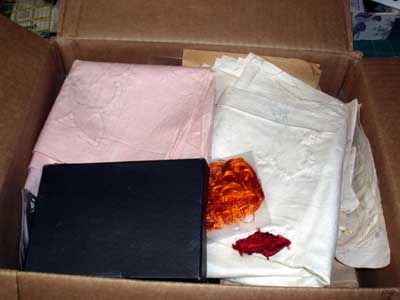
The contents of this box undoubtedly date to the late 1800’s – early 1900’s, during that era of “Silk Art Embroidery” or “Society Silk.” Well, certainly some of the threads date from the mid-1800’s up to 1917 (I’d guess closer to 1917).
Inside the box, I found a heap of unworked, stamped linens, featuring tea cloths, doilies, and the like. The majority are printed with “natural” looking floral designs, typical of the “Silk Art Embroidery” style (or “Society Silk”). Very few of them are partially worked, and none are completely worked. I’ll show you the linens a bit later.
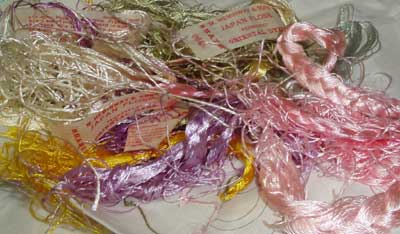
Tucked inside some of the linens were skeins of silk floss – in different degrees of disarray. Some will need attention to get them back in order; others are neatly braided.
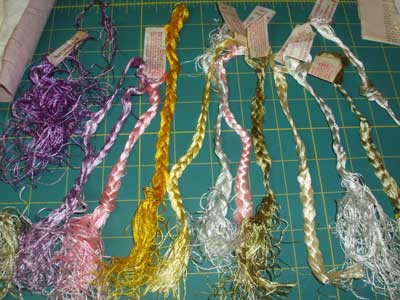
Regardless of their current situation, all the threads are gorgeous! The sheen is incredible – the silk is just beautiful! I am looking forward to the challenge of separating and straightening out the different colors and weights of silk!
When I removed the linens from the box, I discovered more silk! Someone had already tried to organize this bunch, using small plastic bags.
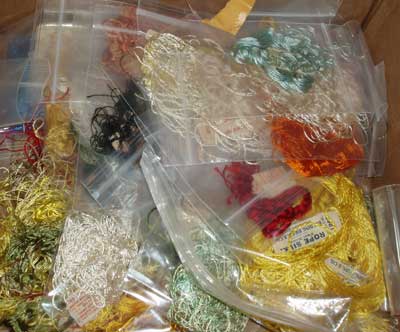
The majority of the silk was manufactured by M. Heminway & Sons:
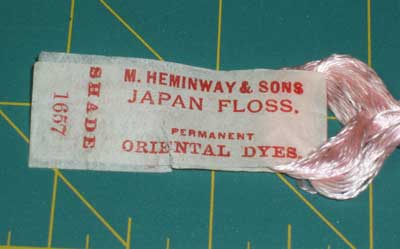
Merrit Heminway was the first manufacturer to spool silk in the US. From the mid-1800’s through 1917, his company (formerly Bishop & Heminway) was called M. Heminway & Sons Silk Company. In 1917, the company was sold to Hammond Knowlton & Co, and the name was changed to H.K.H. Company. So somewhere between the establishment of of M. Heminway & Sons Silk Company and the selling of it to H.K.H., these threads were made. An expert who’s studied the subject in-depth could probably look at the label and be a bit more precise as to the age of the thread, but there’s no doubt that the era is certainly the “Silk Art” or “Society Silk” era of embroidery.
The popularity of this style of embroidery, which is essentially needlepainting flowers and other natural florals on linen and other ground fabrics using fine silks, lasted from the around the 1880’s through about 1915 – 1920. According to Donna Cardwell in her book Silk Art Embroidery: A Woman’s History of Ornament and Empowerment, the term “society silk” comes from the organization (The Society of Decorative Art) that taught the skills of this type of needlework all over the country and in Canada. Silk Art Embroidery has an interesting history and is worth reading about. Don’t be too put off by the title of the book above – I was afraid it was going to be entirely a “social history” book, but it isn’t. It contains interesting history and lots of technique information.
While it is evident from this box of goodies that the stitcher was definitely stitching household linens, I can’t help wondering if they were for her or if they were being made to sell as a source of income? Was she just dabbling in the new embroidery rage? Or was she seriously trying to learn the technique in order to supplement income? These things, I will probably never know – but it’s fun to wonder!
Incidentally, this type of thread was not used solely for “Silk Art Embroidery.” This was the silk embroidery floss available in the US at that time, and you can see it on a multitude of ecclesiastical work from that time period, as well. I’ve always wanted to see the threads they used in ecclesiastical work from the early 1900’s, up close. When looking at different pieces, it’s evident that the pieces were stitched with lightly twisted filament silk. And finally, here’s a whole box of it!
I’ll be sorting through this as I have time, and I’ll also be showing you the linens, in case you’re curious!
Thanks, Freda, for thinking of me!







Mary, these threads are beautiful! I had the honor of helping a dear friend build a deacon's stole for her ordination in the Episcopal Church. She had made cross stitch pieces of each of the 4 Evangelists out of silk threads hand-carried from Ireland by her (I think)great great aunt during her immigration to the States at the turn of the century.
We figured out how to put them on hidden "frames" so they could be removed from the stole for laundering or for transferring to other stoles if another liturgical color was needed later.
The threads were much like the ones you show here in your post. The connection to the past when using threads like this is amazing.
Uau!!! What a treasure! It's a real treasure.
Hope you show the linens; I'm really curious!
WOW!!!!!! This is indeed a treasure. Every once in a while I'll come across a box of sewing supplies from way back when but nothing as grand as this. You're a lucky duck! 🙂
How can you tell if the sewing notion is old? If the package of rick rack is from J.C. Penney and cost 8 cents, you know it's not from the fabric store downtown. 🙂
How wonderful! What a lovely thing to get from someone. I have found sewing baskets at antique shops, usually from an estate autions, with the threads, needles, pincushions still in them, just as the owner left them. I have often wondered what the last thing they were working on was. I once found a small box full of individual strands of threads, all colours, in a glorious tangle. I pictured someone stitching a flower garden, pausing to select just the right pink, perhaps to finish off the foxgloves in the corner…
Wow! What a treasure you have in that box! The threads are gorgeous! Imagine the possibilities 🙂
MGM
oo, you lucky duck!
quack! quack!
hope the sorting/detangling goes well.
You have indeed acquired a treasure trove of wonders! Silk HAS to be the nicest thread – who care about working with it, I just like to fondle it! Have fun with your new stash.
Ooo so blessed. That's about the only way I will probably ever get to try out some silk threads but the odds of me getting those kind of hand-me-overs are zero to none.
Now you must bless us less fortunate with photos of how you use them. Please, just among the other one million things you do to share with us. 🙂
Wow!! the threads are beautiful and they have lovely sheen to it. You are very lucky to have them.
have fun with them.
till then take care.
Regards,
Kirti
Hi Mary, Ruby sent me here after she saw my vintage thingies post. I'll have a question to you later, but I just wanted to show you some silk threads I have inherited from my dear great aunt. I have shown them here: http://kotkarankki.blogspot.com/2008/11/vintage-thingies-thursday-7.html
Hello Mary. I just wanted to say I have enjoyed reading your blog so much. Its been my pet project to put some of the antique silk needlework books online at the antique pattern library. this summer I have been putting up images of the colored embroidery plates up on flickr http://www.flickr.com/photos/23170389@N03/sets/72157618996546560/
Luann
WOW, Luann! The photos are GORGEOUS – I will have to write about your flickr page, so readers can enjoy it, too!
Thank you SO MUCH for sending the link!
MC
Love your blog! I love finishing up the old dresser scarves, table cloths and buffet sets that I come across, so having a lovely collection like yours is a must. We also have a huge collection of these old silks and have them for sale in our Etsy shop if anyone is looking for particular colors or types. http://www.finiribbon.etsy.com
I always look forward to what you will share next, thanks Mary!
Lisa
Thanks, Lisa! & Thanks for the link to your etsy store – what a great resource!
MC
Browsing along your site today and I enjoyed reading this so much! When I find something – a book, a project – that someone else has read, created, loved – it’s almost like being with the person. Even when a person has passed on, they remain.
I’m looking forward to hearing which lucky person won your last book give-away, too. I feel a bit of an special connection with all of the people who share the affinity of beauty through the arts, and who congregate together through your teachings and the wonderful things you share to inspire all of us, whether we are sewing or just need to enjoy a burst of beauty.
You are a curious cat like me! Love your musings. 🙂
I have a cross stitch pattern from 1996 and i dont know where to look fir the colors because the number codes have changed . Is there a way i could find out how to correspond those numbers to dmc
I have a pattern for a babies bonnet called “Classic Beauty”. It is crocheted with 1/8-oz. Embroidery Twist, by
M. Heminway & Sons. It calls for -pure white “D” 0r “E”, 10 spools (45 yds to spool). Can you please tell me how I can
get these materials, and what the cost would be. I live in Victoria, BC Canada.
Thank you so much
Hi, Joyce – Thanks for your comment. I don’t really work too much with crochet yarns and threads, as this is an embroidery website, but I do know that M Heminway & Sons has been long out of business. You might be able to contact a place like lacis.com to see if they would have a recommendation for you.
Joyce, do you have anything similar to a gauge? I ended up here for about the same reason you did, and I suspect the closest option manufactured today is either laceweight or cobweb silk yarn, or silk cord designed for stringing beads. You can get the cord pretty easily (I tend to order from Fire Mountain – it’s a jeweler and bead supply company), though I don’t know what size you’ll need.
Good luck!
Amazing how common beautiful silk threads were at that time. I struggle to find anything close to crochet silk these days.
I’m not surprised M. Heminway & Sons sold when they did. War destroys far more than buildings and flesh.
Hello, after a brief search I found your post. My Mother-in-Law just gifted me with a box of Heminway Japan floss. Thank you for your research, it was great to find out what it is. Gaye.
I found an old half size wooden sewing thread spool (warranted 10 yards) with M. Hemingway & Sons, manufactory Watertown, Conn, established 1849 engraved onto the spool. I thought it was interesting to share.